The COVID-19 pandemic caught many industries off guard, and the call center sector is no different.
With the onset of the pandemic, customer service BPOs like the Philippines-based Phoenix Virtual Solutions had to find ways to adapt to a remote work environment and move away from on-premise technology and in-house call center representatives.
In doing so, many faced challenges, which proved to be lessons in disguise.
In this article, we’ll highlight seven of the biggest lessons learned from a WFH call center agent experiment conducted by Phoenix Virtual Solutions.
Let’s dive in.
7 pivotal lessons learned from a WFH call center agent experiment
Virtual Phoenix Solutions is a 450-seat call center in the Philippines providing virtual customer service, bookkeeping and accounting, medical billing, and data entry solutions to healthcare providers, medical facilities, and management companies in the United States and Australia.
Here are seven crucial lessons learned from Phoenix Virtual Solutions’ WFH call center agent experiment:
Lesson 1: Invest in the right tech stack
Remote call center employees need access to the relevant virtual call center software to collaborate effectively and succeed in their remote job.
Likewise, call center managers and supervisors need tools that give them a better view of employee work habits and progress. This way, they can determine additional ways to boost productivity and keep clients in the loop.
Here’s are some of the types of platforms your virtual call center needs:
- Instant messaging and video conferencing: By investing in communication and video conferencing platforms like Slack, Zoom, and Microsoft Teams, your work-from-home call center can replace informal watercooler chats with ease and foster collaboration with remote team members effectively.
- Work and task management: Task management tools like Trello and Zoho can help call center managers assign tasks and deadlines to call center reps. Managers can also track progress on these tasks, identify bottlenecks, and inform clients of the outcome of projects.
- Client relationship management (CRM): CRMs like Salesforce and HubSpot store customer data, such as previous customer service tickets, purchase history and chat history, which can help a customer service representative resolve customer issues quickly. Contact center agents can also use purchase history data to make outbound calls and follow-up calls to the right customers.
- Time tracking: Time tracking tools provide remote team members with structure, visibility, and accountability. They also help supervisors boost quality assurance, better manage workloads, and get insights into agent performance. With a time tracking tool like Time Doctor, your remote call center can generate accurate billing and payroll, manage projects easily, and improve customer care.
Learn more about Time Doctor’s powerful features.
What’s Time Doctor?
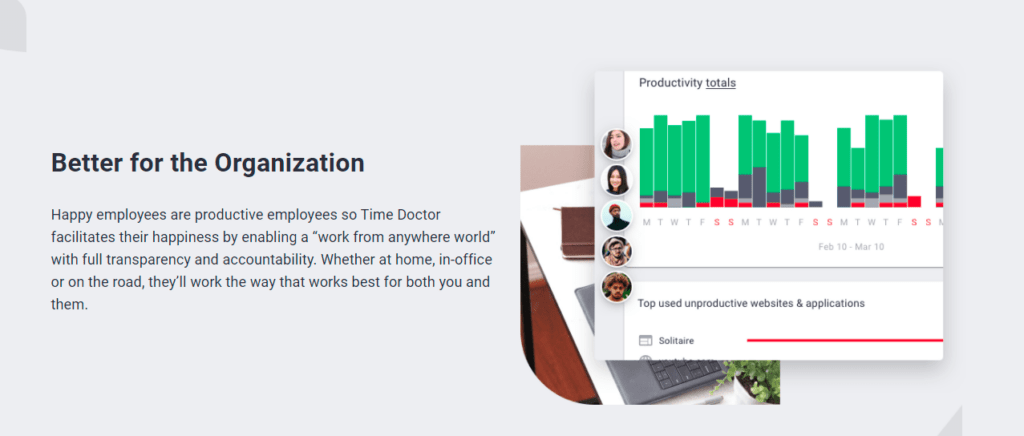
Time Doctor is a feature-rich time tracking and productivity management software used by major companies, like Verizon and Ericsson, as well as by small businesses, like Thrive Market, to boost productivity and coach against unproductive habits.
How virtual phoenix solutions used Time Doctor to boost client retention and productivity
With the onset of the pandemic, Virtual Phoenix Solutions was looking for a way to gain deeper insights into their remote workforce while simultaneously providing accurate data to their clients.
By investing in Time Doctor, they could use the app’s detailed reports, screencasts, and work schedules to boost client revenue and employee productivity.
Additionally, by relying on Time Doctor’s client login access feature, they could keep clients satisfied and loyal.
The call center also boosted its profitability using Time Doctor’s built-in payroll and billing features.
Key features
Here are some of Time Doctor’s main features:
A. An intuitive time tracker
Time Doctor provides call centers with an interactive and silent time tracking option.
Using the interactive time tracker, agents will have to physically click start and stop to start and pause the time tracker. The app will only collect time data while the timer is on.
On the other hand, the silent timer automatically tracks time once the computer is turned on.
Call centers can use this feature to track how long a remote agent spends on a customer call.
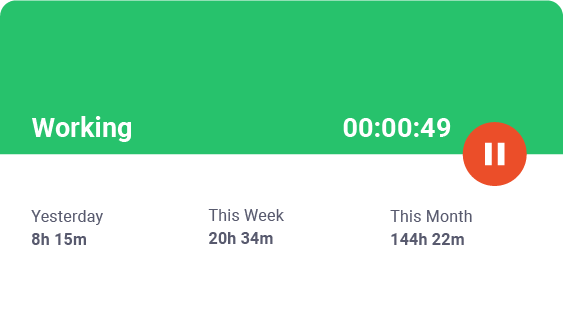
B. Optional screencasts
With Time Doctor’s optional screencast feature, a call center manager can get real-time insights into what their customer service reps are working on.
Time Doctor also has a Premium Plan video recording feature. With it, you can see how your contact center agents handle a specific customer interaction or incoming call.
This will also help managers determine if agents are following call center best practices and if a remote call center agent needs further customer support training.
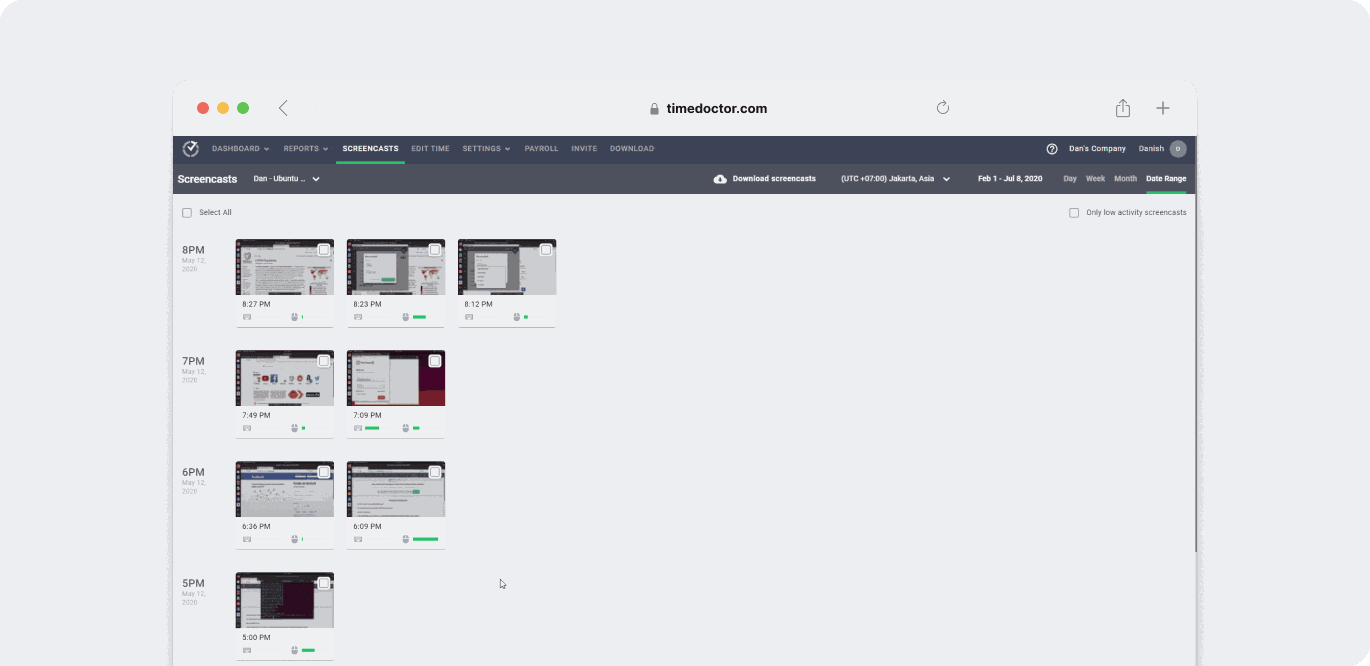
Note: Administrators can blur sensitive information in the screenshot to protect agents’ privacy.
C. Web and app monitoring
Time Doctor also displays the apps and websites every agent uses while on the clock.
It also assigns each website and application a productivity rating:
- Productive
- Unproductive
- Neutral
- Unrated
And don’t worry, you have the option of determining which apps and websites should be categorized as ‘unproductive.’ This way, your remote contact center agents can view customer complaints via social media sites without the activity being flagged.

D. Comprehensive productivity reports
Time Doctor generates a wide range of productivity reports, like:
- Activity reports: Track the time employees spend active, idle, or unproductive.
- Hours reports: Monitor the total hours each employee tracked in a day or selected period.
- Projects & tasks reports: See the hours tracked for specific projects and tasks.
- Timeline reports: Get a visual timeline of every employee’s workday.
- Web and app usage reports: See which websites and apps your employees accessed while on the clock.
- Attendance reports: Monitor when employees were present, absent, or late for work.
- Custom exports: Send custom reports to your clients to keep them informed.

E. Employee work-life balance insights
Time Doctor’s dashboards feature a most work-life balance potential issues widget. This widget can help call center managers identify remote agents struggling to balance their personal and professional lives.
This includes any work from home call center agent who work:
- Too many hours during the week.
- Late hours.
- Outside their stipulated shift.
- On weekends.
This is a valuable feature for any inbound and outbound call center since employee wellness, employee satisfaction, and a healthy work-life balance significantly influence how productive a call center representative can be.
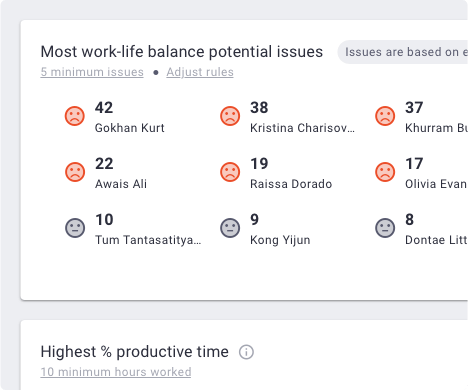
F. Work scheduling
Most call centers rely on call volume to determine staffing levels, but it can be challenging to manage work schedules manually.
Fortunately, Time Doctor’s work schedule feature lets managers easily create work schedules for their part-time and full-time remote customer service team members.
Here’s what can you do with this attendance tracking feature:
- Add or modify a single shift or make bulk edits.
- Create flexible shifts for any period up to a week.
- Set different schedules for callers.
- Access detailed attendance reports.
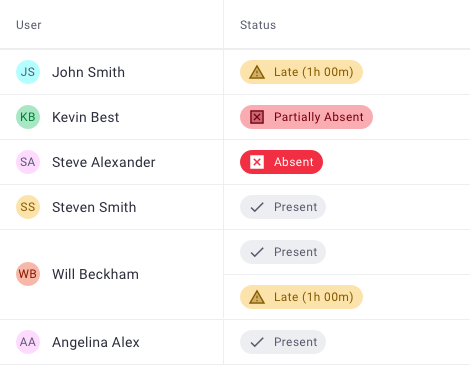
Lesson 2: Prioritize employee autonomy
While it can be daunting to lose direct visibility into what your remote call center agents are doing while on the clock, giving your employees the space to work independently is still crucial.
Suppose you’re concerned about your remote employees being unproductive or spending too much time on social media. In that case, you should know that Phoenix Virtual Solutions discovered a 56% decrease in unproductive time and a less than 1% change in social media use.
Additionally, low-performing remote call center agents spent about 3% of their day on Instagram, while high-performing employees didn’t open Instagram at all while working their remote call center job.
As a result, it’s a good idea to shift your focus from monitoring employees’ social media time to monitoring core customer experiences metrics like customer satisfaction and net promoter score to determine your call center’s performance.
Discover other crucial call center metrics.
Lesson 3: Build a positive team culture
Remote call center agents can’t bounce ideas off their colleagues while taking lunch or walk over to their supervisor when they need help.
So, how can you ensure your virtual call center team has a positive work experience while working from home?
Remote call center owners can invest in virtual team-building activities, group video calls, one-on-one calls, online chat tools, and other methods to promote cohesion and connectivity throughout the workplace.
Another solution is encouraging inbound call center agents to get on video customer calls, not just phone calls. This is because video calls can help remote agents feel less alone and isolated. The added benefit is that your customers will receive a more human customer service experience, while your inbound call center can create a highly engaged and productive remote workforce.
Phoenix Virtual Solutions boosted its employee net promoter scores by 10% after six months of remote work by prioritizing employee wellbeing, communication, and connection.
Lesson 4: Encourage work-life balance
In a traditional workspace, it’s entirely normal for employees to work a few extra hours when they need to meet a deadline. It’s also common for traditional business models to celebrate such dedicated employees.
But with the introduction of work from home (WFH), many employees started working overtime and putting in hours over the weekends. According to Phoenix Virtual Solutions, top performers spent more time working on the weekends once they shifted to a remote work environment.
Additionally, a National Bureau of Economic Research study showed that most remote workers worked an extra 48.5 minutes daily. In the long run, this can lead to widespread employee burnout, resulting in disengaged employees and decreased productivity.
As a result, customer service BPOs need to encourage every agent to implement boundaries between their work from home jobs and personal lives.
Managers can do this by keeping track of their agents’ working hours and reminding them to take breaks – precisely what Phoenix Virtual Solutions did.
By relying on Time Doctor, they could monitor their employees’ working hours and detect any work-life balance issues.
In doing so, many employees reported that they improved their sleep patterns, physical health, diet, and overall emotional wellbeing while going about their remote call center job.
Lesson 5: Provide continuous one-on-one feedback
Continuous feedback in the form of one-on-one calls between supervisors and employees can help remote call centers create a well-connected remote workforce.
During these calls, employees can voice their concerns and share their future goals, while supervisors can discuss areas in which the agent excels and where further coaching is required.
By using Time Doctor’s screencast feature and productivity reports, you can easily spot where an agent needs additional coaching. In doing so, supervisors can refer to accurate analytics and even show customer service agents where they went wrong.
Here are some tips for training remote employees.
Lesson 6: Extend continuous feedback to clients
Having the right client communication skills can help you foster trust and loyalty between your remote call center and clients. This, in turn, can lead to greater customer satisfaction and increase the likelihood of clients recommending your call center service to others.
Once Phoenix Virtual Solutions adopted a WFH model, they had to find a way to maintain transparency between their remote call center and their clients.
As a result, they used Time Doctor’s client login access feature and detailed reports to keep clients in the loop and skyrocket their client retention and acquisition rates.
Lesson 7: Cybersecurity risks are real
Although cyber security risks existed before 2020, the pandemic brought these risks to the forefront of many remote businesses’ concerns.
Since most call centers weren’t prepared for the sudden shift to a remote workforce, they had to quickly deploy the relevant call center software to ensure their employees could collaborate and provide the best customer experience.
The problem?
A study found that 74% of recent cyberattacks on businesses happened due to security flaws introduced by remote work technology.
In many cases, cybercriminals used illegitimate domain names to harvest sensitive information from employees.
However, with Time Doctor, you can benefit from safety best practices like two-factor authentication, encrypted data transfer and regular penetration testing, patching, and security audits.
Additionally, Time Doctor only uses the information you provide to authenticate users, find and prevent fraud; and block and remove unsafe or fraudulent users from the Platform.
Although there are many measures remote companies can put in place to tackle cybersecurity risks, cyber security will still remain a significant challenge for outsourcing companies going forward.
The added challenge here is that many industries that rely on BPO service providers often have strict compliance demands that are already difficult to execute with remote work. This is especially true for banking, finance, healthcare, and eCommerce clients.
Here’s how you can create a call center security policy.
Key takeaways
The sudden shift to WFH meant that call center managers had to find new ways to gain insight into their employees’ productivity, while the remote call center agents had to find ways to stay productive and connected.
For call centers like Phoenix Virtual Solutions, this presented many challenges, lessons, and opportunities.
And while the COVID-19 pandemic took many industries by surprise, you can avoid staying in the dark by investing in an employee productivity monitoring tool like Time Doctor.
With Time Doctor, you’ll have access to comprehensive productivity reports, an intuitive time tracker, work scheduling features, and more.
Skyrocket your remote team’s productivity levels by signing up for Time Doctor’s 14-day free trial today!


